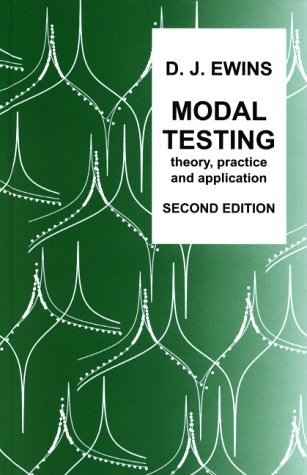Modal Testing: Theory, Practice and Application
2nd Edition
by D.J. Ewins
|
Modal testing is a method for measuring the natural frequencies,
damping ratios, and mode shapes of a structure.
Ewin's textbook describes how to conduct
and interpret a modal test, ensuring that the reader understands
the physics and the mathematics behind modal testing as well
as learning the newest and most powerful applications to date.
|
Table of Contents
Overview
Introduction to Modal Testing
Applications of Modal Testing
Philosophy of Modal Testing
Summary of Theory
Summary of Measurement Methods
Summary of Modal Analysis Processes
Review of Test Proceduresand Levels
Terminology and Notation
Theoretical basis
Single-Degree-of-Freedom SDOF) System Theory
Presentation and Properties of FRF Data for SDOF System
Undamped Multi-Degree-of-Freedom (MDOF) Systems
MDOF Systems with Proportional Damping
MDOF Systems with Structural (Hysteretic) Damping – General
Case
MDOF Systems with Viscous Damping – General Case
Modal Analysis of Rotating Structures
Complex Modes
Characteristics and Presentation of MDOF FRF Data
Non-sinusoidal Vibration and FRF Properties
Complete and Incomplete Models
Sensitivity of Models
Analysis of Weakly Non-linear Structures
Response Function Measurement Techniques
Introduction and Test Planning
Basic Measurement System
Structure Preparation
Excitation of the Structure
Transducers and Amplifiers
Analysers
Digital Signal Processing
Use of Different Excitation Signals
Calibration
Mass Cancellation
Rotational FRF Measurement
Measurements on Non-Linear Structures
Multi-point Excitation Methods
Measuring FRFs and ODSs using the Scanning LDV
Modal Parameter Extraction Methods
Preliminary Checks of FRF Data
SDOF Modal Analysis Methods
MDOF Modal Analysis in the Frequency Domain (SISO)
Global Modal Analysis Methods in the Frequency Domain
MDOF Modal Analysis in the Time Domain
Modal Analysis of Non-Linear Structures
Derivation of Mathematical Models
Modal Models
Refinement of Modal Models
Display of Modal Model
Response Models
Spatial Models
Mobility Skeletons and System Models
Applications
Comparison of an Correlation of Experiment and Prediction
Adjustment or Updating of Models
Coupled and Modified Structure Analysis
Response Prediction and Force Determination
Test Planning
|

